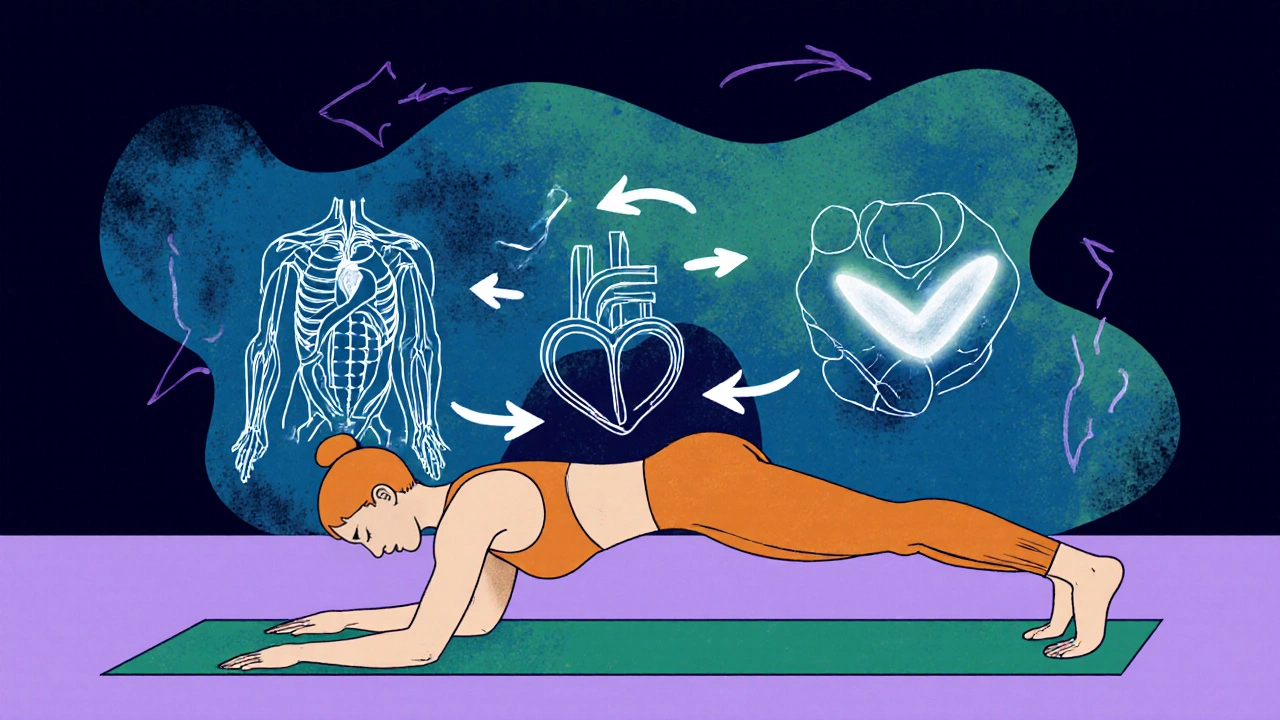
Yoga Calorie Calculator
How Many Calories Did You Burn?
Your Calorie Burn
Note: These are estimates based on average studies. Your actual burn may vary based on body weight, intensity, and individual metabolism.
When you see a yogi moving through a flow, you might wonder how they stay so lean without lifting heavy weights or pounding the treadmill. The answer isn’t a single magic trick - it’s a mix of how the body works, what they eat, and the lifestyle habits they adopt. Below we break down the real reasons behind that slim look and give you practical steps to tap into the same benefits.
Yoga is a mind‑body practice that blends postures, breath work and meditation. It isn’t just a stretch routine; it’s a full‑body workout that can spark the metabolic changes needed for a lean physique. Another key player is the Lean Body a state where muscle mass is balanced with low body fat, resulting in a toned appearance. Together they create a feedback loop that keeps the metabolism humming and the waistline in check.
Understanding the Lean Look
First, let’s clear up a common misconception: leanness isn’t just about burning calories. It’s about body composition - the ratio of muscle to fat. Yoga builds functional muscle, especially in the core, legs and back, without the bulk that comes from heavy‑weight training. Those muscles are metabolically active, meaning they burn more calories at rest compared to fat tissue.
How Yoga Influences Metabolism
Two physiological factors drive the metabolic boost you get from yoga.
- Metabolism - Regular practice raises your resting metabolic rate (RMR) because of increased lean muscle and the after‑burn effect (known as excess post‑exercise oxygen consumption, or EPOC). Even a gentle Vinyasa flow can keep your metabolism elevated for up to an hour after you finish.
- Calorie Expenditure - While a typical Hatha class might burn 180‑250 calories per hour, a vigorous Ashtanga session can top 500 calories. The continuous flow, combined with holding poses, spikes heart rate and forces the body to work harder.
These effects add up. If you practice five times a week, you could be burning an extra 1,500‑2,000 calories a month without feeling like you’re doing a “hard” workout.
The Role of Core Strength & Muscle Tone
Strong core muscles are a hallmark of lean yogis. As you hold plank variations, boat pose, and arm balances, you’re recruiting deep stabilizer muscles that other workouts often neglect. These muscles improve posture, making the waist appear slimmer, and they also support better movement patterns that reduce injury risk.

Nutrition & Mindful Eating
Yoga isn’t just about the mat; it extends to the kitchen. Many yogis follow a Mindful Eating approach that aligns with the breath‑aware mindset cultivated on the mat. Here’s how it works:
- Eat slowly and focus on the flavors, which allows the brain to register fullness sooner.
- Choose whole, minimally processed foods - think fresh veggies, fruits, legumes, nuts and seeds.
- Avoid eating large meals right before a practice; a light snack keeps energy steady without feeling heavy.
Studies show that mindful eaters tend to consume 10‑15% fewer calories over a week, a factor that easily contributes to leanness when paired with regular yoga.
Stress Reduction & Hormonal Balance
High stress spikes cortisol, a hormone that encourages fat storage around the belly. Yoga’s emphasis on breath work - Pranayama - triggers the parasympathetic nervous system, lowering cortisol levels. Consistently lower cortisol means the body is less likely to hoard fat and more inclined to use stored energy.
Common Myths Debunked
Myth 1: Yoga doesn’t build enough muscle. While it’s true yoga isn’t bodybuilding, the sustained holds create muscular endurance and hypertrophy in postural muscles, which translates to a lean look.
Myth 2: You need a strict vegan diet to stay thin. Diet quality matters more than label. Many yogis thrive on balanced omnivorous meals, as long as they prioritize whole foods and portion control.
Myth 3: Only intense styles burn calories. Even gentle restorative sessions improve insulin sensitivity and reduce inflammation, both of which aid fat loss over time.

Practical Tips to Get Lean with Yoga
- Mix styles: Combine a dynamic Vinyasa flow (3‑4 times a week) with a calming Yin or Restorative session to aid recovery.
- Incorporate strength poses: Practice arm balances, inversions and deep lunges to challenge muscles.
- Track your breath: Use a simple 4‑4‑6 breathing pattern during asanas to improve oxygen use.
- Stay consistent: Aim for at least 30‑45 minutes daily; consistency beats occasional marathon sessions.
- Mindful meals: Put down the phone, chew each bite 20‑30 times, and stop when you’re 80% full.
By following these steps, you’ll tap into the same mechanisms that keep yogis lean, without needing a gym membership.
Yoga Style Comparison
| Style | Avg Calories/Hour | Intensity | Core Emphasis |
|---|---|---|---|
| Ashtanga | 500 | High | Strong |
| Vinyasa | 350‑450 | Medium‑High | Moderate |
| Hatha | 180‑250 | Low‑Medium | Light |
Frequently Asked Questions
Does yoga replace cardio for weight loss?
Yoga can be a cardio alternative when you choose dynamic styles like Ashtanga or Vinyasa. While the calorie burn per hour might be lower than running, yoga also improves muscle tone, flexibility and stress levels, all of which support long‑term fat loss.
How many days a week should I practice to stay lean?
Aim for at least five sessions of 30‑45 minutes each. Mixing higher‑intensity flows with gentle recovery days keeps the metabolism active while preventing burnout.
Can beginners achieve a lean look with yoga alone?
Yes, beginners can start with Vinyasa or Power Yoga to build strength and burn calories. Consistency, mindful eating and stress management are the three pillars that drive leanness, regardless of skill level.
What role does breath work play in staying lean?
Breath work, especially Pranayama, improves oxygen delivery to muscles, lowers cortisol, and can boost the post‑exercise calorie burn by up to 10%.
Do I need a special diet to see results?
You don’t need an extreme diet, but focusing on whole foods and practicing mindful eating helps keep calorie intake in check while supplying the nutrients your body needs to recover from practice.
